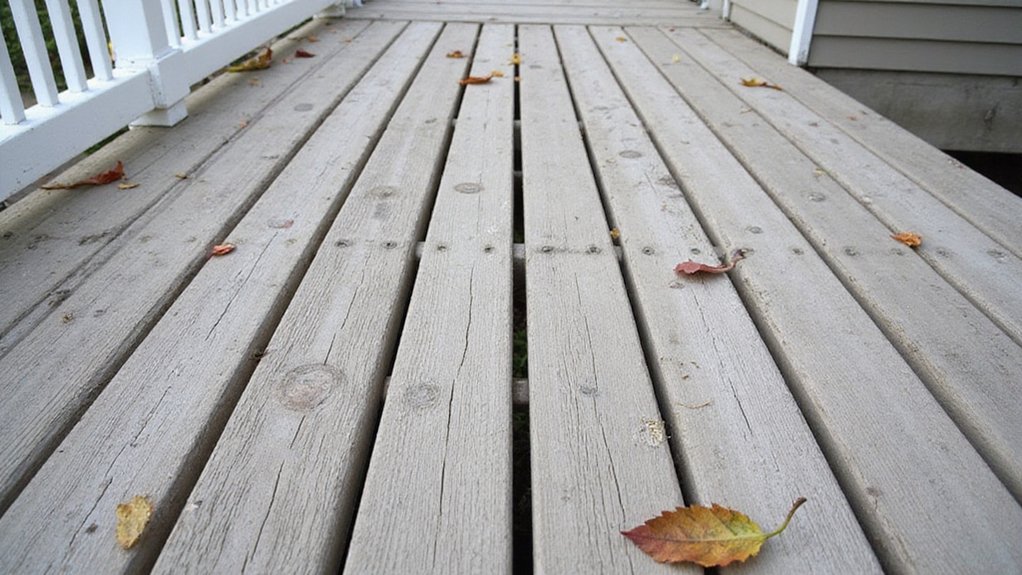As you step out onto your deck or porch in Erie, you’re likely aware of the harsh weather conditions that come with living in this beautiful city. But have you stopped to think about how those freezing temperatures, heavy lake-effect snows, and constant moisture are affecting your deck or porch coatings? The reality is, these extreme weather conditions can cause cracks, peeling, and delamination, and that’s just the beginning. Let’s take a closer look at how Erie’s climate is putting your deck and porch coatings to the test.
Temperature Extremes Take a Toll
As you traverse the complexities of deck and porch coatings in Erie, temperature extremes arise as a fundamental factor to contemplate. The region’s prolonged winter, characterized by freezing temperatures, can severely impact your deck or porch’s coating. Freeze-thaw cycles, where water seeps into the coating and expands as it freezes, can cause cracks and damage.
When the temperature rises, the water thaws, and the cycle repeats, leading to further deterioration. This constant expansion and contraction can lead to a weakened coating, making it more susceptible to damage from other environmental factors. It’s crucial to choose a coating that can withstand these temperature fluctuations, ensuring your deck or porch remains protected and secure. A durable, weather-resistant coating will help you maintain your outdoor space, even in the face of Erie’s harsh winters. Additionally, using waterproof paint can prevent moisture damage and mold growth, further protecting your deck from the harsh effects of temperature extremes.
The Impact of Lake-Effect Snow
Lake-effect snow, a hallmark of Erie’s climate, can greatly influence your deck and porch coatings. As a homeowner in this region, you’re no stranger to persistent snowfall and wind-driven precipitation. These harsh winter conditions can take a toll on your outdoor spaces, causing coatings to degrade faster than in other areas.
Heavy snow loads can cause coatings to crack and split, allowing water to seep in and cause damage. Wind-driven precipitation can drive snow and ice into the smallest crevices, leading to premature wear. The constant freeze-thaw cycle can cause coatings to expand and contract, leading to delamination and peeling. Snow removal methods, such as shoveling or plowing, can scratch or scrape coatings, creating vulnerabilities. The sheer volume of snowfall can lead to an increased risk of ice dams, which can cause water to back up under coatings and cause damage. To combat these issues, consider professional services that offer durable high-quality finishes for exterior projects like decks and porches.
Moisture Damage: A Silent Destroyer
While you’re busy shoveling snow or enjoying winter activities, moisture damage can quietly wreak havoc on your deck and porch coatings. Moisture seeps into the wood’s pores, causing water staining and discoloration.
As temperatures fluctuate, the water inside the wood freezes and thaws, expanding and contracting, which can lead to cracks and further damage. Additionally, trapped moisture creates an ideal environment for mold growth, which can spread quickly and destroy your coatings.
If left unattended, moisture damage can compromise the structural integrity of your deck and porch, leading to costly repairs or even replacement. It’s critical to address moisture damage promptly by inspecting your coatings regularly and addressing any issues before they escalate. By doing so, you can safeguard your investment and guarantee your outdoor living spaces remain safe and enjoyable for years to come.
Wood Expansion and Contraction
Every winter, your deck and porch coatings face a formidable foe: wood expansion and contraction. As temperatures fluctuate, the wood in your deck and porch undergoes a process of expansion and contraction, which can cause coatings to crack and fail. This natural process is exacerbated by Erie’s humid continental climate, where moisture absorption rates are high.
Wood grain patterns can affect how much moisture is absorbed, with some patterns allowing more water to penetrate than others.
When wood expands, it can push against the coating, causing it to crack or peel away. Conversely, when wood contracts, it can create gaps and voids that allow water to seep in. This constant cycle of expansion and contraction can weaken the bond between the wood and the coating.
If not properly addressed, wood expansion and contraction can lead to costly repairs and replacements down the line.
Coatings Under Siege
As wood expansion and contraction wreak havoc on your deck and porch, the coatings themselves are put to the test. The constant flux in temperature and humidity leads to weathering patterns that can cause your coatings to degrade rapidly. You may notice color deterioration, chalking, or fading, which can compromise the protective barrier and expose your deck or porch to further damage.
The harsh Erie weather can also lead to cracks and crazing, allowing water to seep into the substrate and cause even more problems. As the coatings wear down, your deck or porch becomes increasingly vulnerable to rot, decay, and insect damage. It’s critical to choose coatings that can withstand these extreme weather conditions and maintain their integrity over time. By doing so, you can make certain your deck or porch remains safe, functional, and beautiful for years to come.
The Importance of Adhesion
When you apply a coating to your deck or porch, the adhesive properties of that coating play an indispensable role in its overall performance. A strong bond between the coating and the substrate guarantees that the coating will withstand the harsh Erie weather conditions. Weak adhesion can lead to peeling, flaking, and blistering, finally resulting in a failed coating.
To guarantee optimal adhesion, consider the following key factors:
- Surface preparation: Ensure the substrate is clean, dry, and free of contaminants to promote a strong bond.
- Chemical compatibility: Verify that the coating is compatible with the substrate material to prevent chemical reactions that can compromise adhesion.
- Priming: Apply a primer specifically designed for your substrate to amplify adhesion and coating performance.
- Application conditions: Apply the coating in optimal weather conditions, avoiding extreme temperatures, high humidity, and direct sunlight.
- Manufacturer’s instructions: Follow the manufacturer’s guidelines for surface preparation, application, and drying times to guarantee a strong, long-lasting bond.
Choosing the Right Coating for Erie’s Climate
Selecting a coating that can withstand Erie’s unpredictable weather patterns is crucial to the longevity of your deck or porch. You’ll want a coating that resists UV exposure hazards, which can cause fading, cracking, and discoloration.
Additionally, since Erie is a lakefront city, you’ll need to ponder the effects of salt air corrosion. When choosing a coating, look for products with high levels of UV resistance and corrosion protection. Contemplate coatings with specialized additives that help to block UV rays and prevent corrosion.
Also, make sure to select a coating that’s specifically designed for your deck or porch material, whether it’s wood, metal, or concrete. By choosing the right coating, you’ll be able to enjoy your outdoor space for years to come, without worrying about the harsh Erie weather taking its toll.
Frequently Asked Questions
Can I Use Regular Paint on My Deck or Porch?
You can’t use regular paint on your deck or porch; instead, choose a coating specifically designed for outdoor use, such as latex-based or oil-based paints, which provide durability and protection against the elements.
How Often Should I Inspect My Deck or Porch Coatings?
You should survey your deck or porch coatings regularly, ideally with seasonal examinations, to detect any damage or wear early on. Undertake thorough investigations to safeguard the integrity of the coatings and make essential repairs to preserve their durability.
Can I Apply a New Coating Over an Old One?
You’re wondering if you can apply a new coating over an old one? Generally, it’s possible, but you must verify compatibility with prior coatings to prevent peeling or flaking. Applying multiple coatings can lead to a thick, heavy finish, so careful consideration is key.
Will a Waterproof Coating Eliminate All Moisture Issues?
You’ll find that a waterproof coating can considerably reduce moisture issues, but it won’t completely eliminate them, as the coating’s moisture absorption rate and degradation factors, like UV exposure and foot traffic, still come into play.
Can I DIY a Deck or Porch Coating Application?
You can DIY a deck or porch coating application, but timing is indispensable; consider seasonal application timing to guarantee optimal adhesion, and prioritize proper surface preparation to safeguard a successful, long-lasting finish that meets your expectations.

